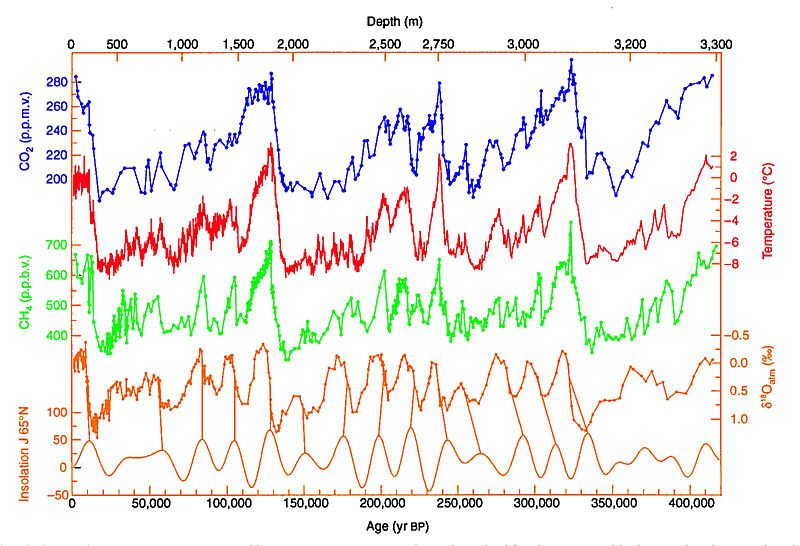The last ice age, according to what I have learned, ended approximately 11,000 years ago.
An ice age, eh? I can only imagine what living during this time must have been like.

Ice ages come and go, and with the in-between times known as the Interglacial periods, they lasted some 100,000 years, data show. There is evidence of such going back some 420,000 years, which means there have been four such cycles in that 420,000-year span. Right now, as it were, the Earth appears to be at the beginning of a cooling period. (Refer to the graph above).
Antarctic ice withdrawn from as long ago as 420,000 years back, as well as more recent samples, have been evaluated. The ice core samples were tested for the purpose of determining, among other things, atmospheric concentration of carbon dioxide (CO2) and methane (CH4) over time. What has been found over those 420,000 years is quite revealing.
From the graph above, what can be learned is that at intervals occurring approximately every 100,000 years, both CO2 (blue line) and CH4 (green line) concentrations reached their peaks each time at near 280 parts per million by volume (p.p.m.v.) and 700 parts per billion by volume (p.p.b.v.), respectively, some peaks being above while others being at or below. Again, notice that the peak-to-peak frequency occurs about every 100,000 years. What matches are the times at which the CO2 and CH4 peaks coincide.
Not only do the peaks in atmospheric CO2 and CH4 align, so, too, do the temperature swings (red line), the range being from -8 degrees Celsius to +2 degrees Celsius, a 10-degree Celsius swing.
In looking at this, naturally I wanted to know the reason behind the cyclical trend. So, I went in search of answers.
What I first wanted to know is if there was any influence from the sun in this regard. Next, knowing there are stores or sinks for both CO2 and CH4, I wanted to find out what could possibly be happening on the Earth to cause the increase (changes) in the atmosphere of both of these greenhouse gases.
What I can conclude in looking at the above graphical data is that during times when the Earth has undergone warming, levels of carbon dioxide and methane in the atmosphere from sinks or stores like soil, plants, oceans, ocean bottoms, permafrost, etc. has risen. Generally speaking, what I notice is that with a change in Earth temperature has come corresponding changes in the levels of both atmospheric CH4 and CO2.
Okay, so why do the cycles repeat at approximate 100,000-year intervals? There appears to be a number of explanations.

In a nutshell, due to the combined influences, the resultant effect is that the shape of the orbital path of the Earth around the sun isn’t exactly identical one year to the next, changing from less elliptical to more elliptical and then going back to less elliptical, until the entire cycle is repeated, each cycle taking 100,000 years to complete. For far greater perspective, see the “Milankovitch cycles” here.
Oh, and there is one other thing: From the ice-core data graph above, with regard to temperature (red line), the period between today (left side of the graph) and about 15,000 years ago, generally speaking and compared to the rest of the temperature line, what is clear is the swings have held relatively steady, ranging between zero and +2 degrees Celsius. The graph also shows that the most recent Earth-warming period started at what looks to be about 20,000 years ago, that actual period of fairly continuous warming lasting roughly 10,000 years. Remember, and to repeat, roughly 11,000 years ago is when the last ice age ended.
So, what if any future effect will the increase in atmospheric greenhouse-gas-emissions concentration caused by the burning of fossil fuels have on the global mean surface temperature in the grand scheme of things? That’s the $64 million question.
Unambiguous, on the other hand, is the rise in mean surface temperature of the Earth since around the beginning of the Industrial Revolution: it’s 1 degree Celsius or 1.8 degrees Fahrenheit. That we know also.
Images: Wikimedia Commons (upper); NASA, Mysid (lower)
– Alan Kandel
This post was last revised on Jan. 13, 2020 @ 6:50 a.m. Pacific Standard Time.